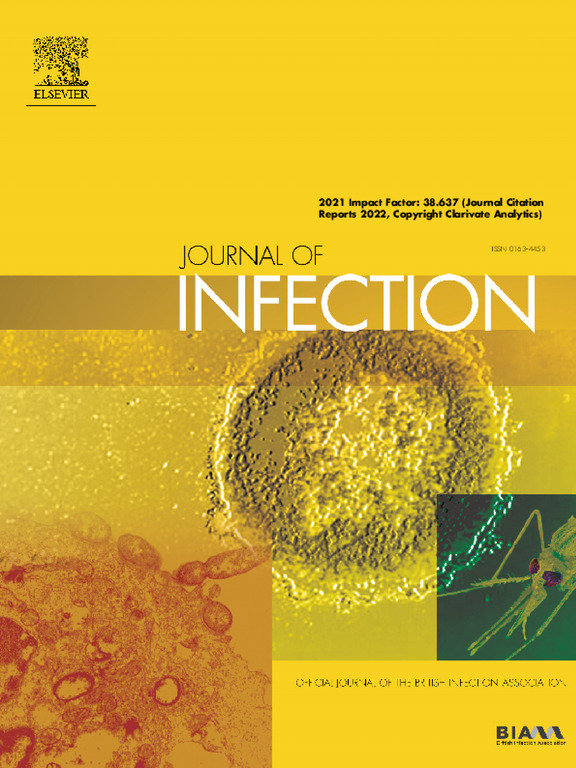一起化脓性链球菌emm5.23暴发的流行病学和基因组特征
IF 14.3
1区 医学
Q1 INFECTIOUS DISEASES
引用次数: 0
摘要
目的:本回顾性横断面研究调查了苏格兰化脓性链球菌基因型emm5.23的流行病学、临床表现和基因组学,该基因型与苏格兰的严重后果有关。方法2014 - 2022年,在苏格兰报告58例与emm5.23相关的侵袭性A群链球菌(iGAS)疾病。对45例病例的监测资料进行临床特征和危险因素分析。全基因组测序(WGS)包括来自苏格兰的所有可用emm5.23菌株(n=58),来自英格兰的一个亚群(n=29),以及来自苏格兰(n=10),英格兰(n=2)和加拿大(n=1)的非5.23亚型emm5菌株。结果几乎所有病例(96%,43/45)住院,其中33%(15/45)需要重症监护,20%(9/45)死于iGAS。最常见的表现是菌血症(51%,23/45)和肺炎(24%,11/45)。WGS在苏格兰发现了一个新兴的emm5.23分支,包含了大多数分离株,它们具有高度相似的基因组和三个非同义多态性。结论虽然没有发现已知的增加GAS毒力的基因组性状,但检测到可能影响emm5.23表型的多态性。这表明emm5.23基因型是短暂成功的,而不是高毒力的,低人群水平的免疫力有助于其传播。这项研究强调了在公共卫生监测中整合实时基因组数据的必要性,以加强来源归因和指导干预措施。本文章由计算机程序翻译,如有差异,请以英文原文为准。
Epidemiological and genomic characterisation of an outbreak of Streptococcus pyogenes emm5.23
Objectives
This retrospective cross-sectional study examined the epidemiology, clinical presentations, and genomics of Streptococcus pyogenes genotype emm5.23, linked to severe outcomes in Scotland.
Methods
Between 2014 and 2022, 58 cases of invasive Group A Streptococcus (iGAS) disease associated with emm5.23 were reported in Scotland. Surveillance data from 45 cases were analysed for clinical characteristics and risk factors. Whole-genome sequencing (WGS) included all available emm5.23 strains from Scotland (n=58), a subset from England (n=29), and emm5 strains of non-5.23 subtypes from Scotland (n=10), England (n=2), and Canada (n=1).
Results
Nearly all cases (96%, 43/45) were hospitalised, of whom 33% (15/45) required intensive care and 20% (9/45) died with iGAS. The most common presentations were bacteraemia (51%, 23/45) and pneumonia (24%, 11/45). WGS identified an emerging emm5.23 clade in Scotland, encompassing most isolates, which shared highly similar genomes and three non-synonymous polymorphisms.
Conclusions
Although genomic traits known to increase GAS virulence potential were not found, polymorphisms that may affect the emm5.23 phenotype were detected. This suggests this emm5.23 genotype was transiently successful rather than hypervirulent, with low population-level immunity contributing to its spread. This study emphasises the need for integration of real-time genomic data in public health surveillance to enhance source attribution and guide interventions.
求助全文
通过发布文献求助,成功后即可免费获取论文全文。
去求助
来源期刊

Journal of Infection
医学-传染病学
CiteScore
45.90
自引率
3.20%
发文量
475
审稿时长
16 days
期刊介绍:
The Journal of Infection publishes original papers on all aspects of infection - clinical, microbiological and epidemiological. The Journal seeks to bring together knowledge from all specialties involved in infection research and clinical practice, and present the best work in the ever-changing field of infection.
Each issue brings you Editorials that describe current or controversial topics of interest, high quality Reviews to keep you in touch with the latest developments in specific fields of interest, an Epidemiology section reporting studies in the hospital and the general community, and a lively correspondence section.
 求助内容:
求助内容: 应助结果提醒方式:
应助结果提醒方式:


